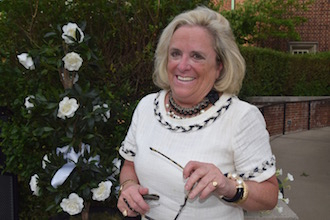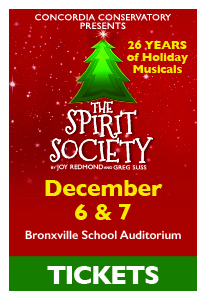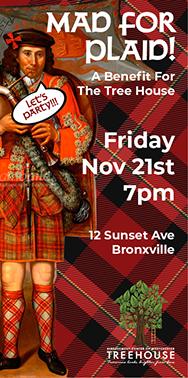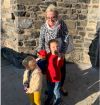From the Mayor: Conserving and Enhancing Bronxville's Natural Environment

By Mary C. Marvin, Mayor, Village of Bronxville
Mar. 13, 2019: Mayor Nancy Hand, my mentor, guiding light, and dear friend, noticed that in my comprehensive plan summation in last week’s column, I glossed over one of the most important aspects of the village – our historic natural landscapes as nature has greatly influenced village life and even our material culture.
As Marilynn Wood Hill wrote in the introduction to The Bronxvlile Historical Conservancy’s latest publication, Defining the Landscapes of Bronxville, “It is the close interrelationship of natural and man-made environments that has given identity to this special place of Bronxville, and we need to exercise a greater stewardship in preserving the whole so that what we leave for future generations will not only be a place to live, but also a place to love.”
The Conservancy publication investigates first the natural features that have determined the character of the current landscape within the village – subsurface geology, hydrology, slopes, soils, and vegetation.
As example, the village has four distinct landscape types: the valley and the village center, the hilltop, the hillside, and the plateau – all of which are very distinct. As a direct result of the sloping land, the hilltop and the hillside are characterized by winding streets to accommodate the change in grade and exposed rock outcrops.
In contrast, in the plateau landscape, where the topography is relatively flat, the street arrangement is more grid-like and homes situated with respect to each other.
Only by understanding the underlay of the village can we develop strategies to conserve and enhance our surrounding environment. As illustration, with regard to vegetation, the Village of Bronxville was originally native woodland and houses were built under a canopy of deciduous trees. Many of these trees have been lost and replaced with ornamental trees, which do not restore the canopy.
Our flooding issues are the direct result of the soil type, ten varieties of which are in the village. Most of Bronxville’s soils are well drained, fine, sandy loam, but soils near the Bronx River are poorly drained because of the high salt content and the high water table.
Other areas of poor drainage include sections along Midland Avenue, the eastern section of Concordia College property, and the area near The Bronxville School.
Early on, these three poorly draining areas most probably were wet meadows or places where ponds formed with spring snowmelt. The name “Pondfield Road” supports this theory.
In contrast, if everyone in Bronxville decided to stop mowing lawns, the land would ultimately revert to forest. Abundant rainfall, temperate climate, fecund soils, and ample growing season assure this inevitability.
What we have to plan for is the proper balance between lawns and a tree canopy. This is particularly important, as the village’s one square mile – 640 acres – contains only a total of 70 acres of parkland. Questions to be asked – do we want more open space, do we need more, and, if so, how do we convert into public ownership?
If we as a community were to reduce the areas of open lawn and replace portions with native ground cover and trees, our soil would be significantly more pervious. The replanting of native canopy trees when one is lost or taken down would help preserve our original natural character.
As an added sustainable bonus, one large hardwood canopy tree can provide one day’s supply of oxygen for four people. Placing no-mow grasses, which are also more pervious, could be used at the edges of fields and in other areas where mowed lawns are not essential. Less lawn area also calls for less irrigation, which would help to reduce the overall runoff, as well. This practice is most important in flood-prone neighborhoods.
Bottom line, planting expansive lawns, raking and blowing leaves, and removing organic matter in the spring and fall are antithetical to nature and the original landscape blueprint of our village.
So as we make changes to land use laws, parking configurations, and permit requirements, the “underlay” of the village must be an integral part of our decision-making as we strive to maintain an authentic, sustainable village.
Note: Most of the above material was sourced from The Bronxville Historical Conservancy’s, Defining the Landscape of Bronxville, co-authored by Mayor Nancy Hand and architect Peter Gisolfi. This publication now serves as the bible for municipal plantings and can be purchased at the village hall front desk and Womrath Bookshop for $30.
Government & History Directory
Bronxville is a quaint village (one square mile) located just 16 miles north of midtown Manhattan (roughly 30 minutes on the train) and has a population of approximately 6,500. It is known as a premier community with an excellent public school (K-12) and easy access to Manhattan. Bronxville offers many amenities including an attractive business district, a hospital (Lawrence Hospital), public paddle and tennis courts, fine dining at local restaurants, two private country clubs and a community library.
While the earliest settlers of Bronxville date back to the first half of the 18th century, the history of the modern suburb of Bronxville began in 1890 when William Van Duzer Lawrence purchased a farm and commissioned the architect, William A. Bates, to design a planned community of houses for well-known artists and professionals that became a thriving art colony. This community, now called Lawrence Park, is listed on the National register of Historic Places and many of the homes still have artists’ studios. A neighborhood association within Lawrence Park called “The Hilltop Association” keeps this heritage alive with art shows and other events for neighbors.
Bronxville offers many charming neighborhoods as well as a variety of living options for residents including single family homes, town houses, cooperatives and condominiums. One of the chief benefits of living in “the village” is that your children can attend the Bronxville School.
The Bronxville postal zone (10708, known as “Bronxville PO”) includes the village of Bronxville as well as the Chester Heights section of Eastchester, parts of Tuckahoe and the Lawrence Park West, Cedar Knolls, Armour Villa and Longvale sections of Yonkers. Many of these areas have their own distinct character. For instance, the Armour Villa section has many historic homes and even has its own newsletter called “The Villa Voice” which reports on neighborhood news.
Link to Village of Bronxville One Square Mile Monthly Newsletter
Village of Bronxville Administrative Offices
337-6500
Open 9:00am - 4pm excluding holidays and weekends
Bronxville Police Department
337-0500
Open 24 hours
Bronxville Parking Violations
337-2024
Open 9:00am - 4pm excluding holidays and weekends
Bronxville Fire Deparment
793-6400

















